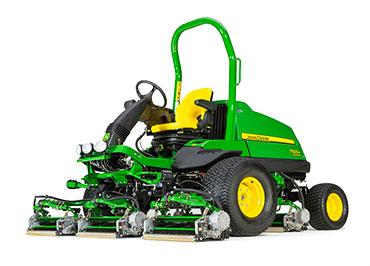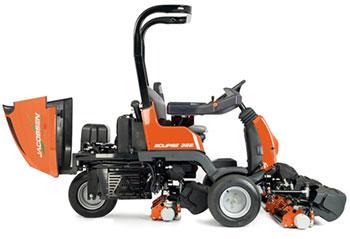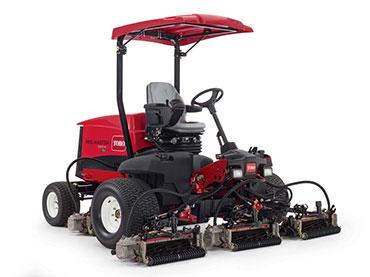 One of the "big splash" product introductions at GIS 2015 was Toro's Reelmaster 5010-H - "the industry's first fairway mower with a true hybrid drive system".
One of the "big splash" product introductions at GIS 2015 was Toro's Reelmaster 5010-H - "the industry's first fairway mower with a true hybrid drive system".
The Toro introduction being no big secret, John Deere countered at the time with a GIS press release documenting "ten years of hybrid technology leadership and innovation".
Always sensitive to marketing-speak buzzwords such as "industry's first", "best-in-class" and the like, and knowing that both Deere and Jacobsen have had "hybrid" mowers in their lineups for many years, these declarations started my "smoke-and-mirrors" meter twitching. OK, here we go, I thought. I had an inkling that further investigation would boil it down to a matter of semantics of definition.
Just like a good accountant or statistician can make numbers tell any story they want, so it can be with sales and marketing (and certainly political) posturing. A foundation of fact is wrapped with window dressing, spin, hype or whatever one wants to call it to give one product a leg up on another.
I didn't make it to GIS this year (a victim of the weather and the Airline Gods, both powers greater than I) so I didn't have my usual opportunity to explore this up close and personal with the product managers. But after reviewing the "hybrid" product lineups from all of the Big Three, I'll admit to being a bit confused... and if I'm confused, no doubt many of you are too. I decided it would be best to do some research and make a few phone calls.
First, let's haul out Webster's Collegiate (at least figuratively) for a moment.
We all know that a hybrid in a biological sense is the offspring of two animals or plants of different breeds, varieties, species or genera. Of course there are F1s and F2s and other classes and subclasses of animal and plant hybrids, but in a general sense "from two comes one".
Beyond biology, the term hybrid has been popularly adapted to many things that arise from or contain combinations of characteristics from two or more distinct items.
Relating this to turf equipment and using a very broad definition, it could be claimed that the first "hybrids" might date to the introduction of hydraulic reel drive (or in the case of Jacobsen, installing hydraulic motors directly on the rotary spindles of their early Turfcats) and then hydraulic wheel motors and hydrostatic transmissions... all this compared to direct mechanical drive systems utilizing geared transmissions, shafts and gearboxes, and I suppose even belts (think National 68 and 84, for those of you who can remember them). With the introduction of hydraulics, one machine had two power systems, or was a hybrid of mechanical and fluid power.
I point this out simply to illustrate that definitions can be tweaked rather easily to suit one's needs.
Most recently, hybrid has been associated with the automotive industry to denote a vehicle that utilizes both an internal combustion engine (ICE) and electric power sources with the implication of greater fuel economy and environmental responsibility. This loose definition was popularized by Toyota with their Prius model.
Let's assume for our purposes here that "hybrid" includes an electric component. Then we'll take a look at how the Big Three interpret and implement hybrid technology... and they are all different.
Note that only Deere and Toro have fairway mowers that use hybrid technology (of any ilk) at this point. Jacobsen's hybrids are limited to their Eclipse triplex and walk greensmowers, but we'll take a look at their technology because it is unique in the industry to date.
First off, let's go back to 2005 when John Deere introduced the 2500E triplex greensmower with electric reel drive. The electric reel drive system, which has morphed over the years into their current E-Cut series of greens and fairway mowers, has obvious benefits of greater control (FOC), lower noise, improved fuel economy and the removal of many potential sources of hydraulic leaks. Note that the power plant was and is still an ICE (gas or diesel), and the mowers still have hydraulic systems for traction, reel lift/lower, steering, etc.
Regarding fuel economy, electrical systems and components are by nature more efficient and thus require less energy than hydraulic systems. Think of the heat given off by hydraulic systems as just one indication of energy inefficiency. Heat is really energy in transfer, and if we need hydraulic coolers and that type of thing to get rid of excess heat from hydraulic systems, it's a pretty good indication of energy not being put to good use. So the better efficiency of electrical systems along with the ability in some cases to operate a mower at less than full throttle (which would otherwise be required to operate a hydraulic system at peak efficiency), hybrid mowers are more fuel-efficient than standard hydraulic units.
Let's look at the methodology of driving the electric reel system, as it is different across the three colors as well.

I spoke with Tracy Lanier, product manager for John Deere Golf, who explained that the current John Deere 2500E, 7500A and 8000A E-Cut models utilize a 48-volt, 180-amp alternator belt-driven off the engine to directly power the reel circuits (only) without an additional battery system. The alternator engages only when the reel drive is engaged, so no power is produced during transport, etc.
Traditional electric components (starter, lights, gauges, etc) are powered by a regular 12v battery. So, in a nutshell, the engine drives an alternator which powers the reel circuits. No extra battery pack.
Part of the benefit of this system, according to Lanier, is that in systems that utilize a battery pack, the battery begins to lose its power immediately when used, so the frequency of clip would change over time as the batteries drain while mowing. By driving an alternator directly off the engine and not relying on battery power, the frequency of clip at the start of the day and at the end of the day is exactly the same.
So there you have it from the 'green' perspective. One might counter that the above statement should perhaps be limited to battery-only systems, and even then regenerative braking would recharge the battery intermittently during the day so it's not a linear discharge all day long.
Chris Fox, product manager for greensmowers and heavy duty utility vehicles at Jacobsen, filled me in on the technology they use on the Eclipse 322 triplex greensmowers, of which there are two: an all-electric (strictly battery-powered) and a hybrid. There's that H-word again.
 All systems -- traction, reel drive, lift/lower and steering -- on both Eclipse 322 models are electric. 48-volt electric motors power each wheel. Reel lift/lower is done via electric linear actuator (think sprayer boom lift), and steering is variable ratio steer-by-wire. All electric/electronic. There is no hydraulic system at all on either of the Jacobsen machines.
All systems -- traction, reel drive, lift/lower and steering -- on both Eclipse 322 models are electric. 48-volt electric motors power each wheel. Reel lift/lower is done via electric linear actuator (think sprayer boom lift), and steering is variable ratio steer-by-wire. All electric/electronic. There is no hydraulic system at all on either of the Jacobsen machines.
The Eclipse 322 Electric has no internal combustion engine (ICE). The drivetrain, in fact, is borrowed from the EZGO RXV electric golf car and modified for this application ("leveraging the technology of our sister company", in marketing-speak). It's a full plug-in system utilizing an on-board high frequency 48-v charger. Regenerative braking also helps to recharge the batteries during use.
Rather than use a battery pack as the sole power source as the Eclipse 322 Electric does, the Hybrid incorporates an ICE (either a 13hp gas or diesel) to drive a generator (the combination of which -- engine plus generator -- is termed a genset). The genset provides primary power directly to the machine.
Unlike the Deere configuration, however, the Jacobsen hybrid also has a 48-v battery pack (albeit smaller than that on the all-electric unit) to supplement the genset power in heavy-demand situations.
"If the unit needs power beyond what the genset can provide then it pulls from the batteries," Fox explained. "At this point the machine is using energy from both the battery and the genset. The genset then charges the batteries when they are below a certain charge."
The limiting factor with the all-electric system is range, or duration of use. Lead acid batteries can only power the unit for so long before the charge runs out, and when it's done, it's done. "We are looking for a lithium solution to further extend the runtime of the electric units," Fox said.
So Deere uses an alternator, Jacobsen a generator. What the difference?
A good resource for alternator and generator theory is here: http://www.rowand.net/Shop/Tech/AlternatorGeneratorTheory.htm. Not laying claim to being an electrical engineer, I'll simply paraphrase some of it below.
Technically, the key difference between an alternator and a generator is what spins and what is fixed. On a generator windings of wire (the armature) spin inside a fixed magnetic field. On an alternator, a magnetic field is spun inside of windings of wire (the stator) to generate the electricity.
In a generator, the current produced is directly proportional to the speed that the armature spins and to the strength of the magnetic field. If you spin it faster, it makes more and if you make the magnetic field stronger it makes more current. The speed of the spinning is controlled by the speed of the engine. A generator can only put out it's maximum rated current at or above some speed - at lower speeds the output drops off very quickly.
An alternator can be "geared up" to spin at speeds higher than engine speed, while also reaching it's maximum output at lower engine speeds (so a car, for example, with an alternator is able to power all electrical components at idle speed) without relying on the battery.
An alternator produces energy only when needed. A generator is working all the time. The Jacobsen units employ a bank of resistors to burn off excess electrical capacity when demand is low and the battery pack is fully charged.
OK, enough electrical theory. On to the Toro hybrid fairway unit.
I spoke with Steven Peterson, marketing manager for Reelmaster products for The Toro Company.
 "Our first challenge when designing a hybrid machine was to define what a hybrid is," Peterson explained. "We gravitated toward the Toyota definition, which includes two energy sources and an energy storage system."
"Our first challenge when designing a hybrid machine was to define what a hybrid is," Peterson explained. "We gravitated toward the Toyota definition, which includes two energy sources and an energy storage system."
In the Toyota model, fuel economy and savings result from use of a smaller displacement engine and a battery storage system that switch off and on -- and in heavy load conditions combine -- to power the machine.
Toro selected a 24.8 hp Kubota diesel engine (note that it's just under the 25 hp limit for Tier 4 emissions regulations), an inline motor-generator and a self-charging 48v battery pack to power the Reelmaster 5010-H. By comparison, the John Deere 7500A E-Cut hybrid uses a 37.1 hp turbocharged diesel engine, and remember... no battery pack.
Cutting units are driven by electric motors, as are those of the other two colors. Traction drive and reel lift/lower are traditional hydraulic, like the Deere system. Jake's traction and lift are electric.
For the battery, Toro uses four 12-volt AGM (absorbed glass mat) batteries rather than traditional flooded (spillable) lead acid batteries to make up the 48-volt system. The AGM batteries are sealed and maintenance free, and are similar to those used in the automobile industry for start-stop hybrids (those where the engine shuts off at a stoplight, and then starts up again upon acceleration). They are designed for long life in a shallow discharge/frequent recharge scenario. Shallow discharge is like when you plug in your cell phone overnight when the battery isn't dead; deep discharge would be when a golf car battery goes dead out on the course and requires a full recharge.
Let's look at the motor-generator for a second. A motor-generator can operate as either an electric motor or a generator, converting between electrical power and mechanical power. Thus, by changing polarity, it can switch back and forth to power the cutting units or add additional power to the traction system when needed.
Toro calls the patent-pending system they developed for this unit PowerMatch. Under normal load conditions the engine drives the hydraulic/traction system and the motor-generator provides the electrical current to power the cutting units.
When hilly terrain or heavy mowing conditions increase the load and require more power, PowerMatch calls for the battery pack to assist the motor-generator, taking some of the load of the cutting units away from the engine (which, of course is driving the motor-generator as well as the hydraulic system) -- thus leaving the engine with more available horsepower for the traction circuit.
In extreme conditions, when maximum power may be required for verticutting, scalping or climbing steep hills, the batteries take on the cutting unit load exclusively and send the reserve battery power back to the motor generator, which reverses polarity and becomes an electric motor. The mechanical power that results provides a boost for the diesel engine in powering the traction system.
The net result, by sensing demand and allocating or re-apportioning power from the engine, motor-generator and battery pack between the reel drive and traction drive circuits, the 5010-H "consistently creates 40+ horsepower in peak mode," according to Peterson.
Toro also states an average of 20% fuel savings with this system, but Peterson added that field testing over the past three years has shown fuel savings much higher than that at the test courses. "Conditions are different everywhere, so we have found it best to under-promise and over-deliver when we can in these situations," Peterson said.
In review, the Deere system utilizes an internal combustion engine to drive an alternator to power the electric cutting units, and the hydraulic system to power the traction, steering and lift/lower circuits. There is no battery pack, as the alternator produces current only when needed and is sufficient to power the electric reel circuit.
Jacobsen has an all-electric (batteries being the only power source) drive system, or an internal combustion engine driving a generator to power the traction, steering, lift/lower and cutting unit drive. The generator also recharges the 48-volt battery pack.
Toro has a small-displacement diesel engine that powers a motor-generator, battery pack and hydraulic system. The motor-generator typically powers the cutting units, but the battery can kick in and do that while the motor-generator shifts to motor mode to produce mechanical power to assist the engine in high-demand situations.
Regardless of the nuances of definition and product features, the take-home message should be that all hybrid systems from each of the manufacturers offer solid benefits of reduced fuel consumption, better control of cutting units, lower noise and fewer leak points... all good things.
For further reference:
US EPA Fuel Economy and Hybrid Technology animation

